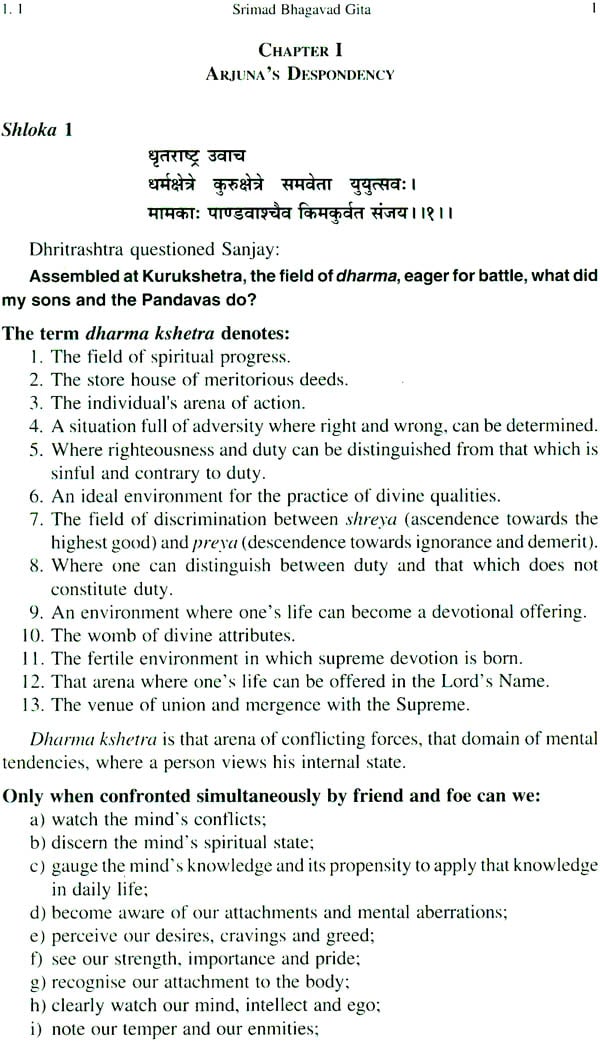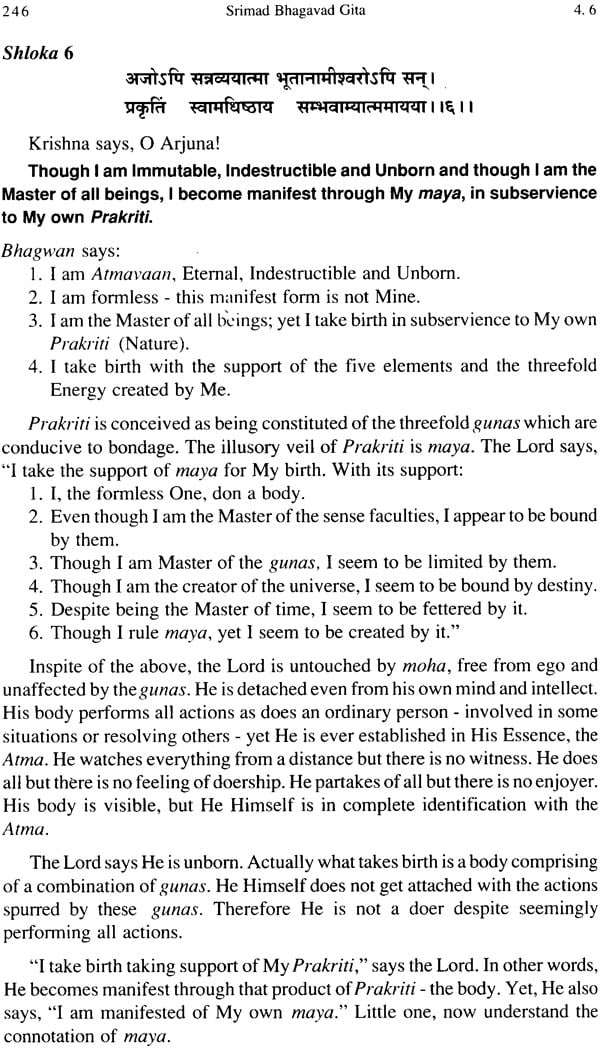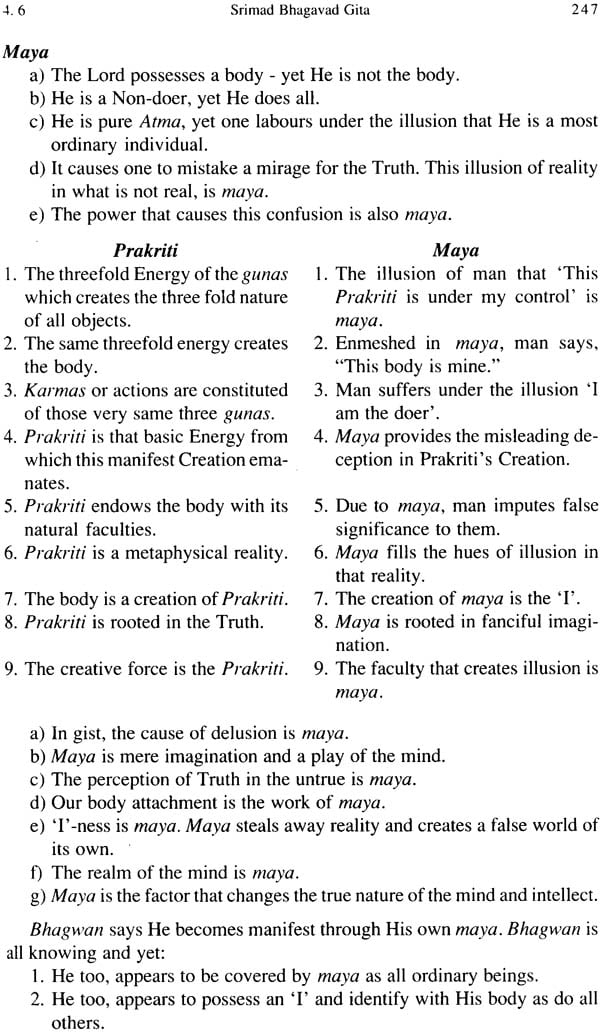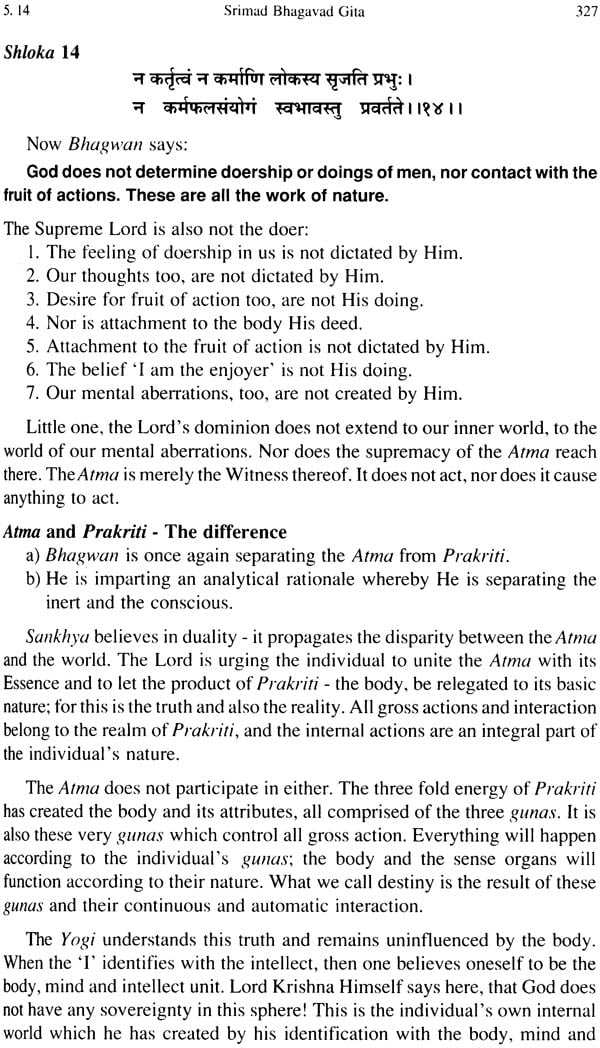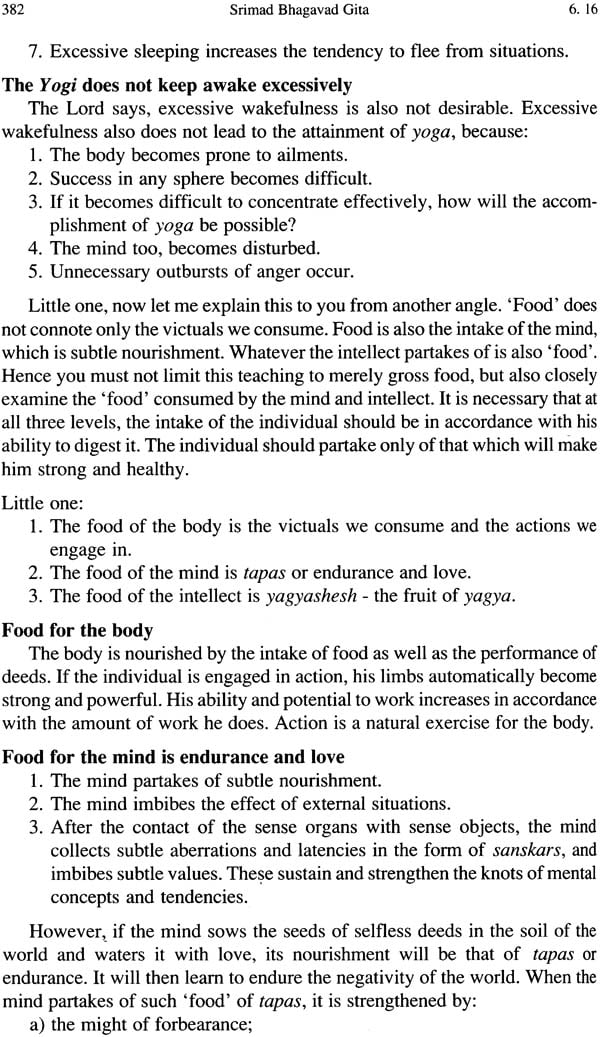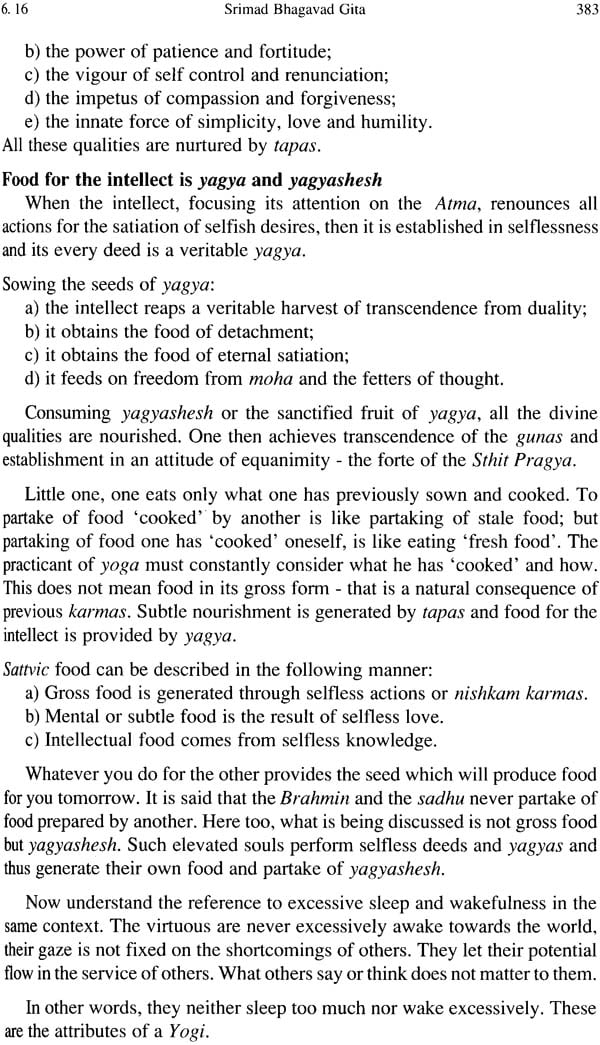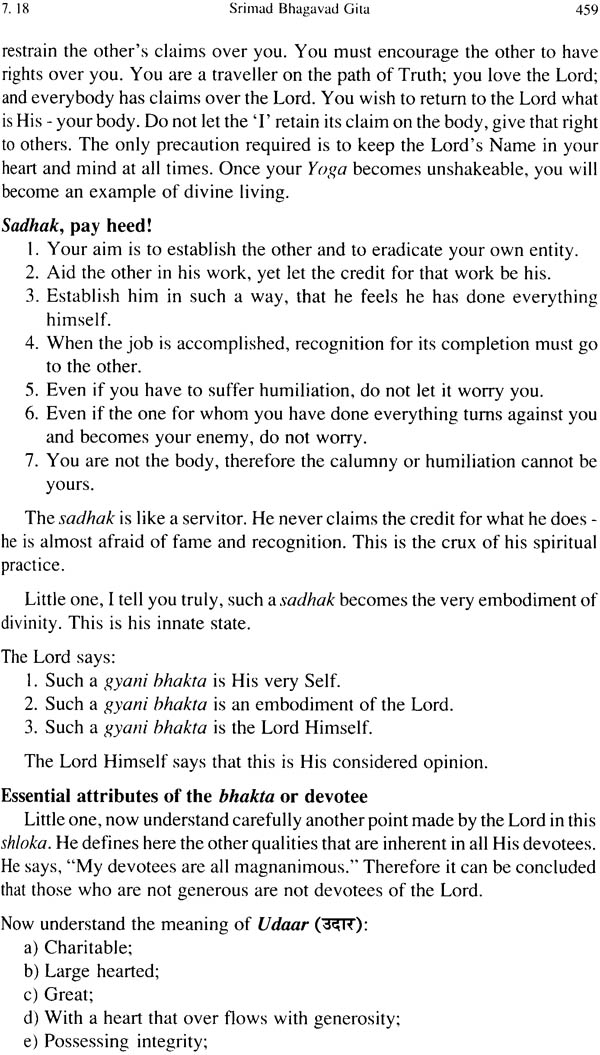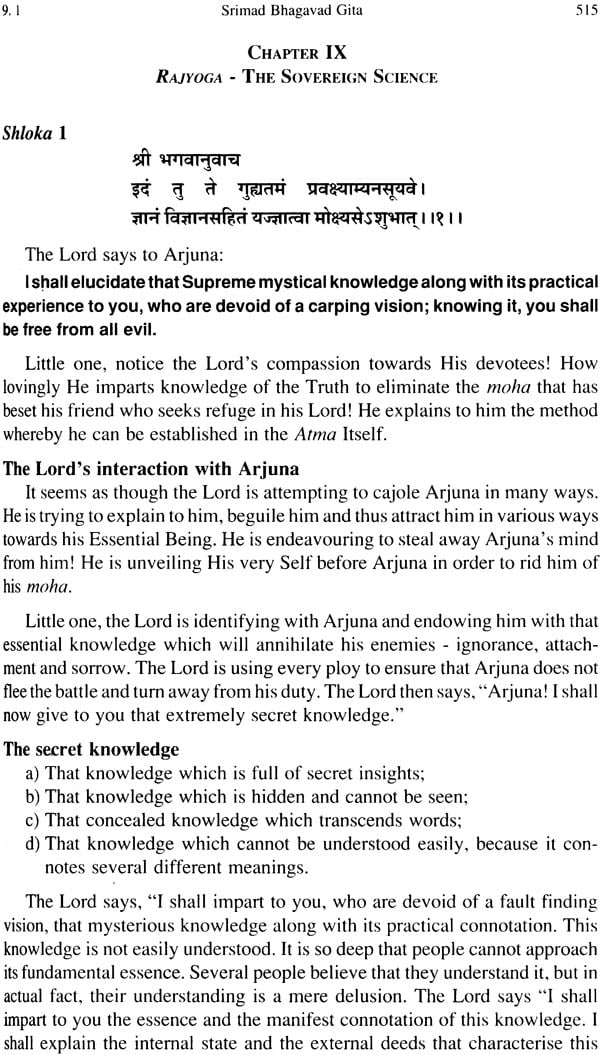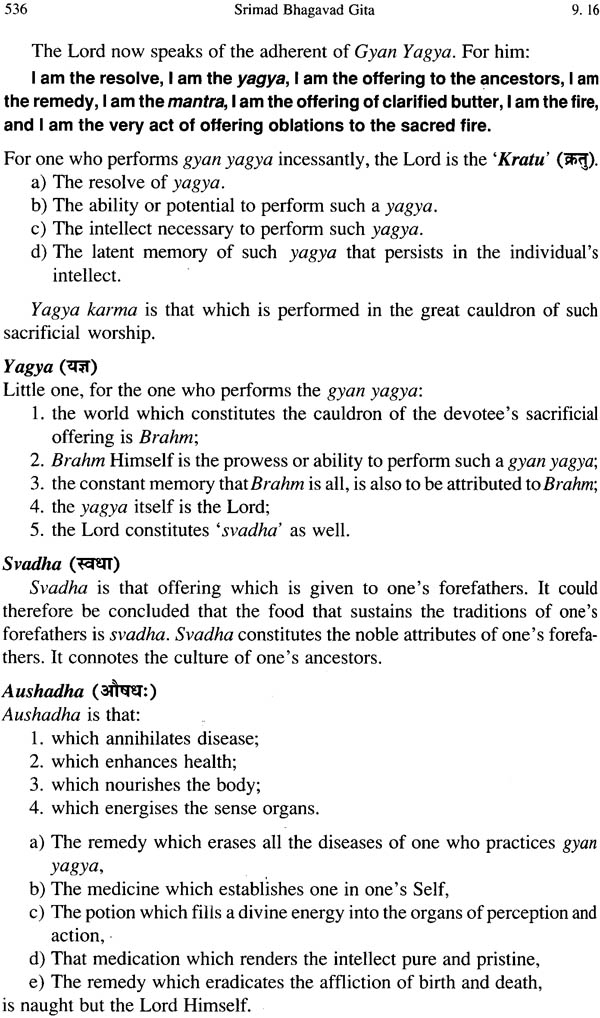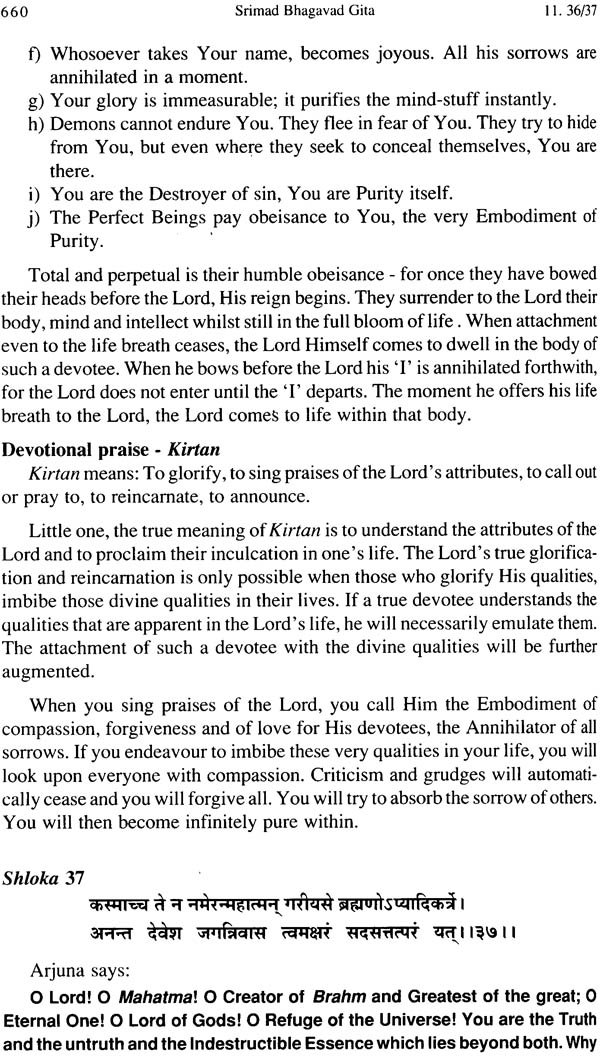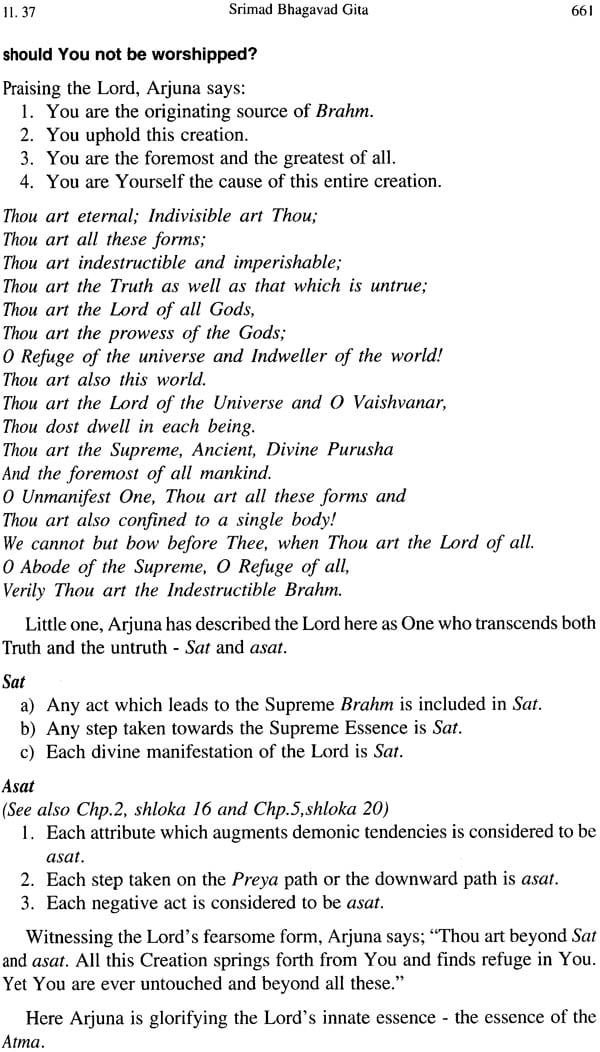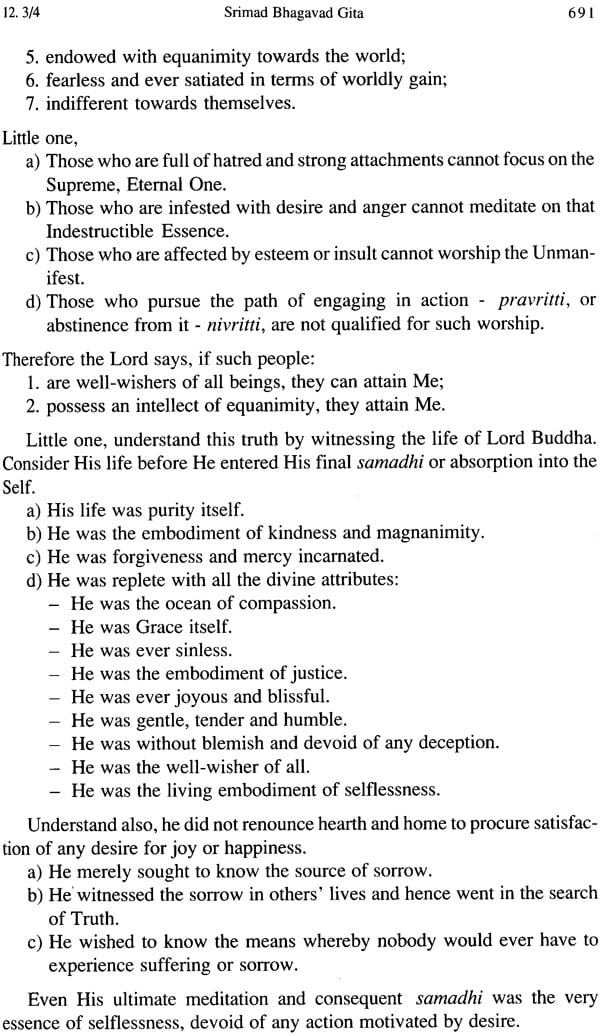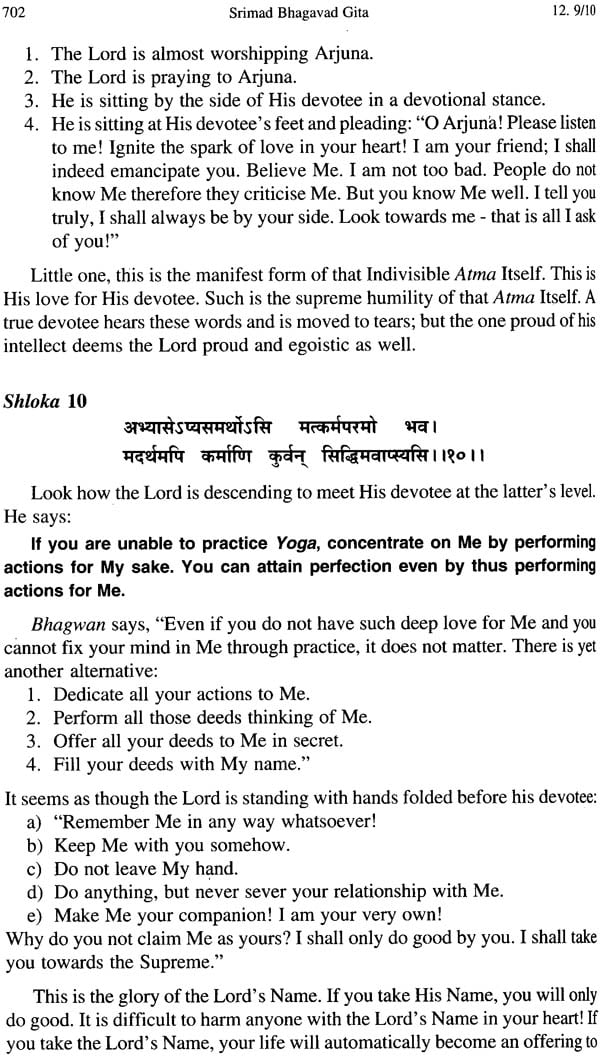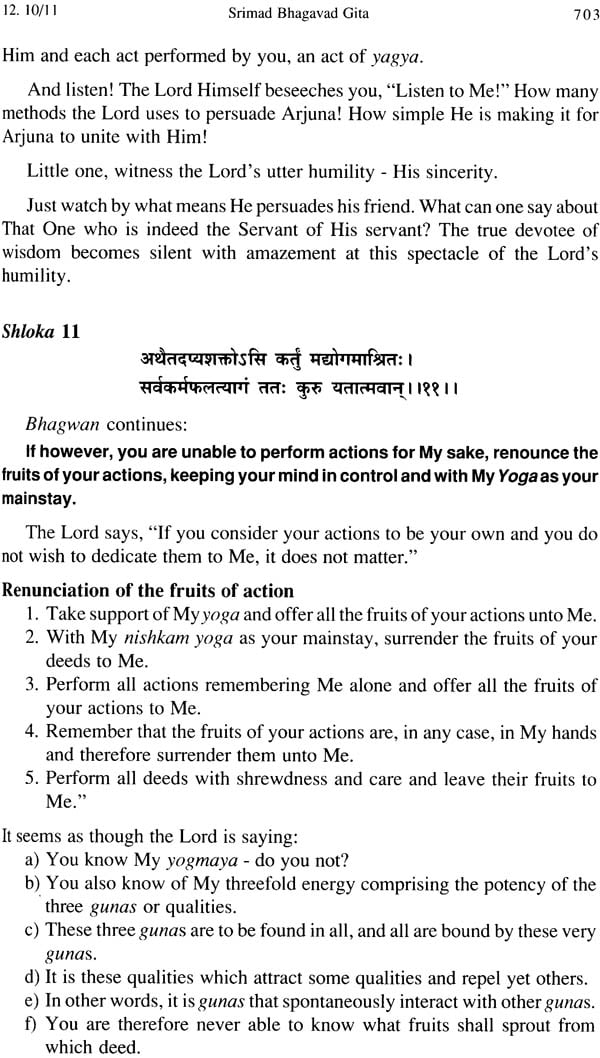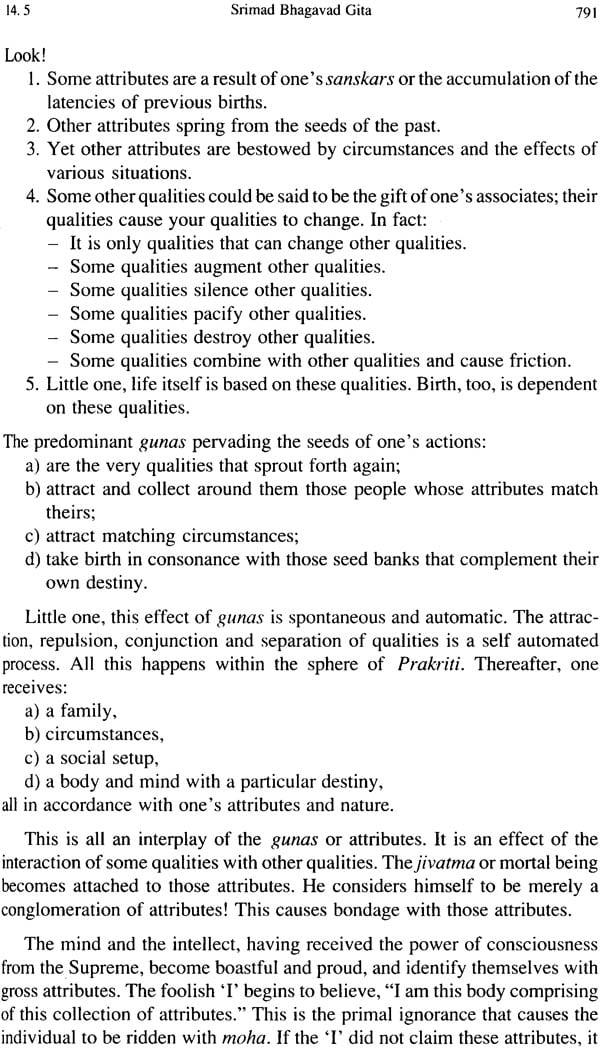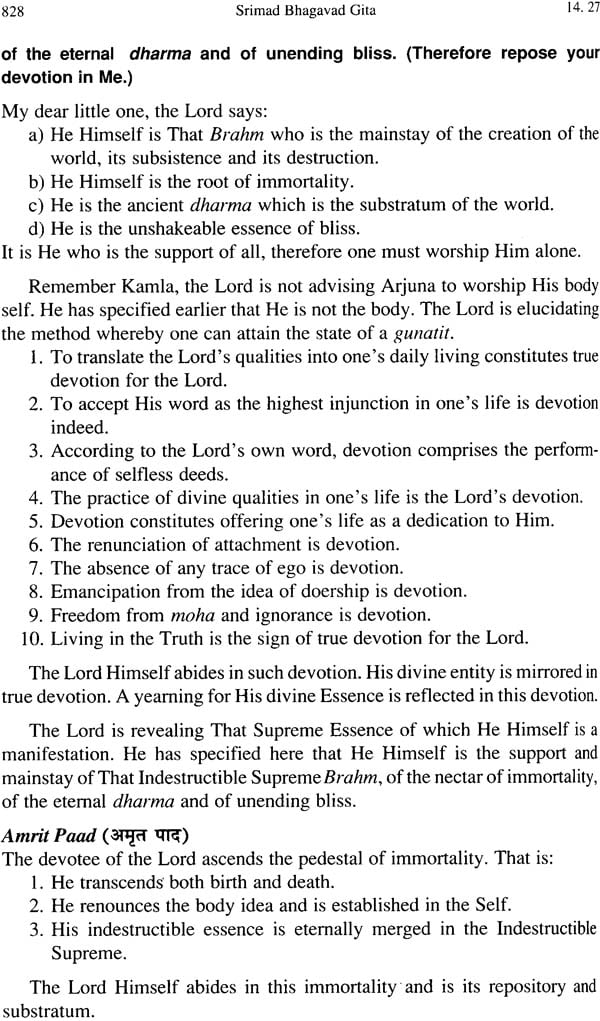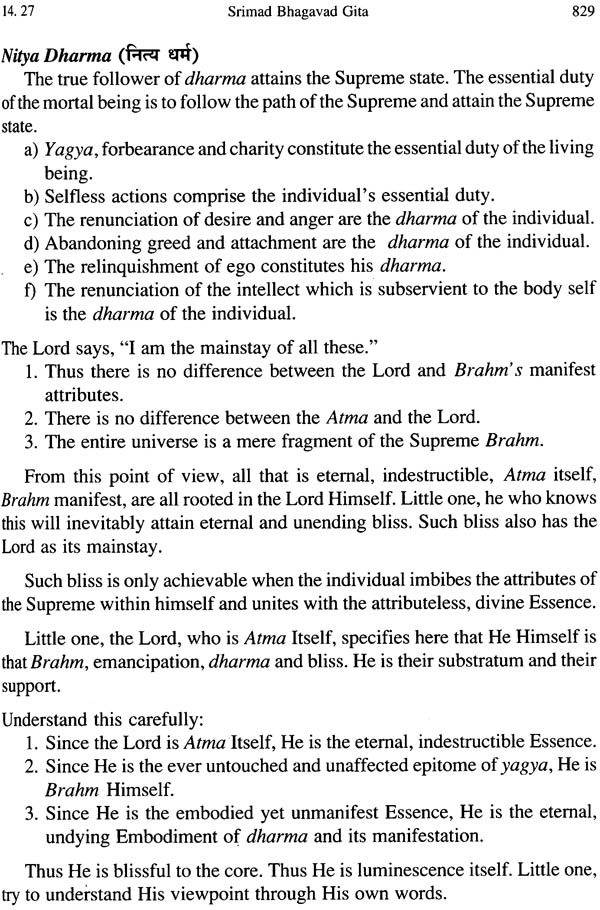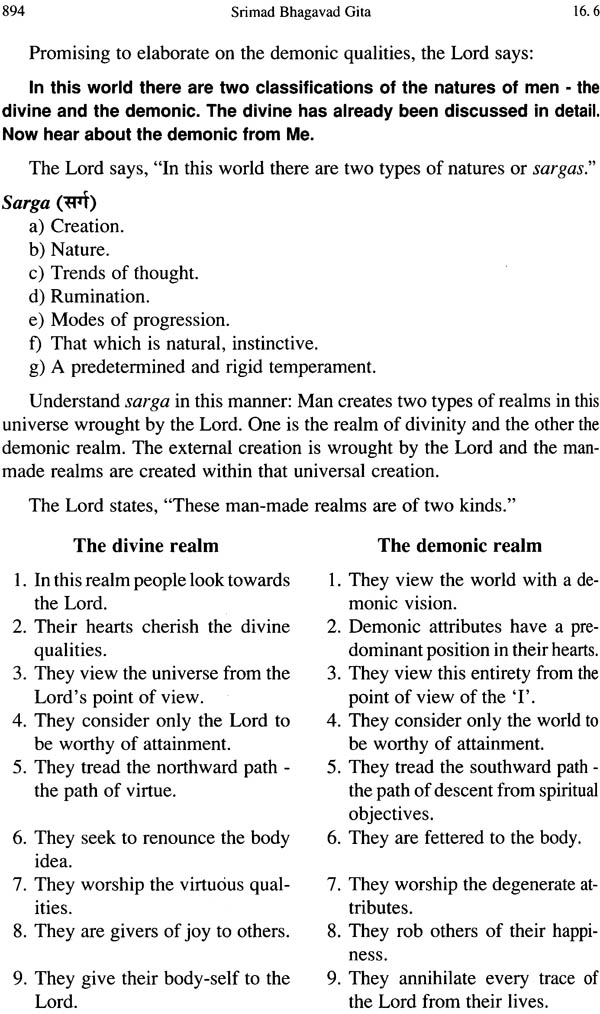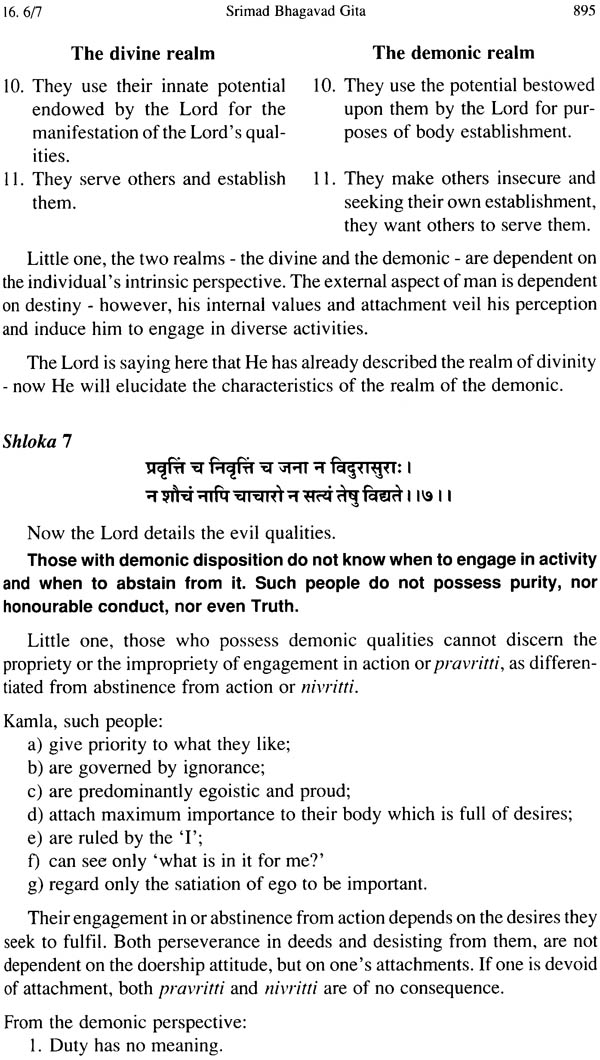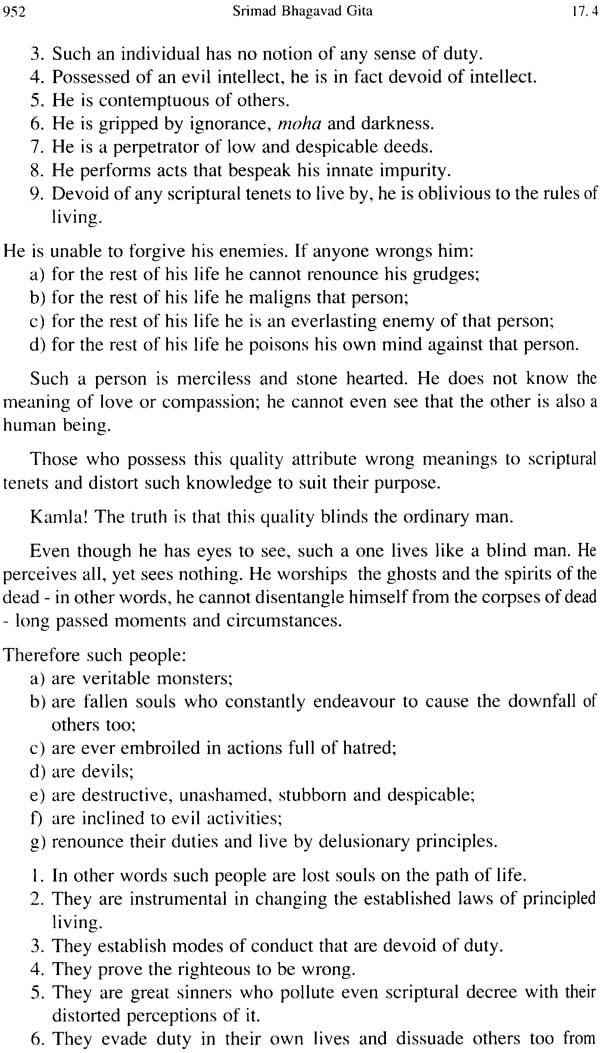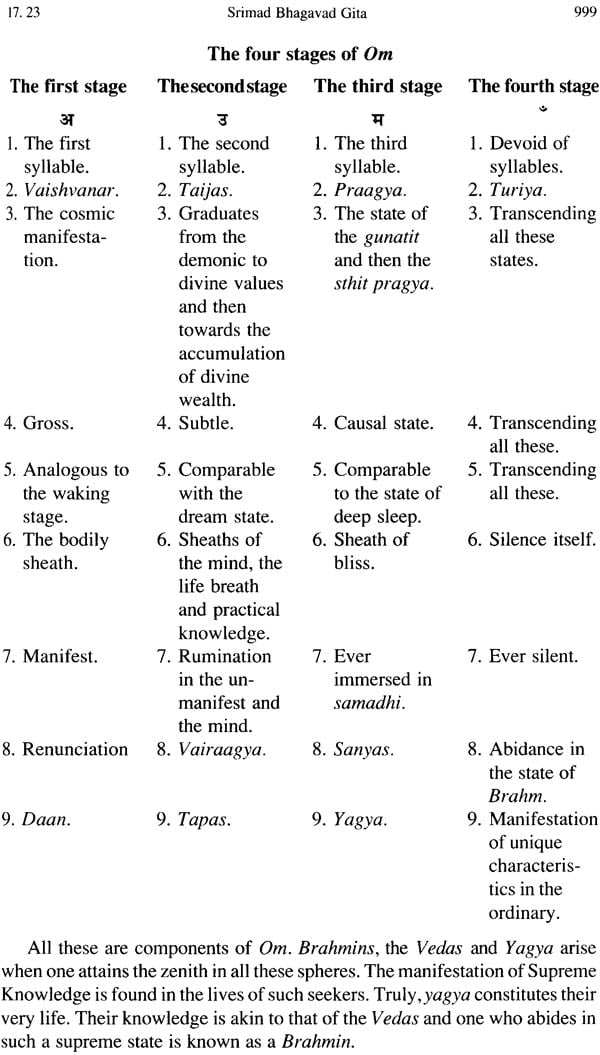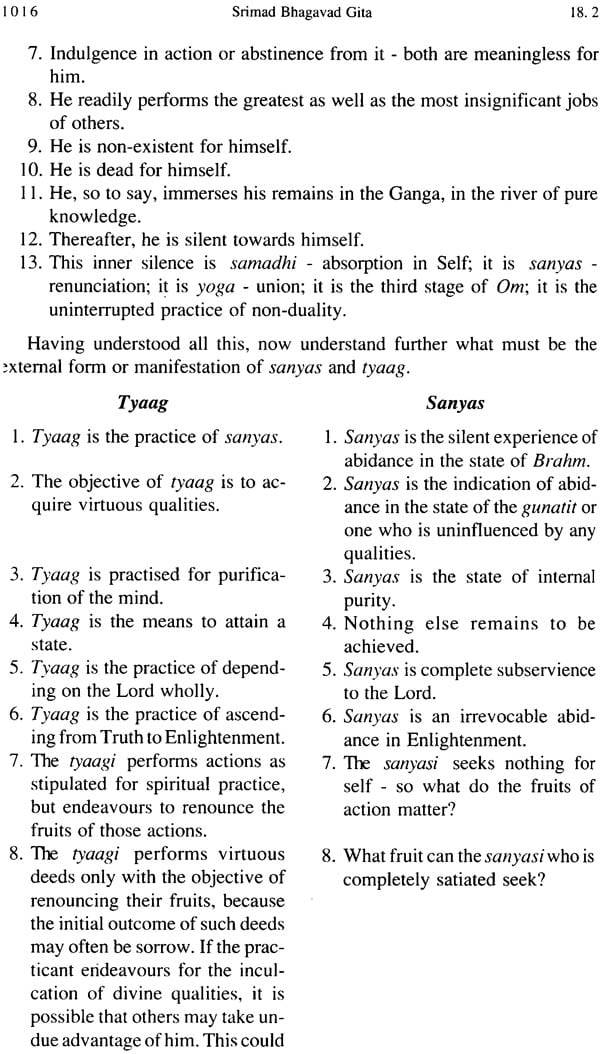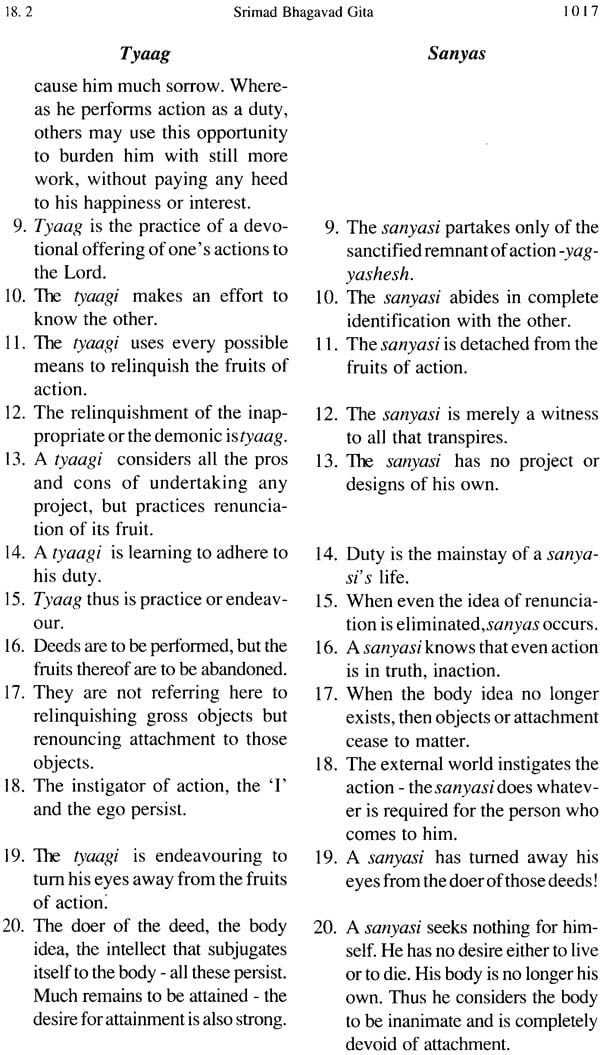
Srimad Bhagavad Gita: A Guide to Daily Living
Book Specification
| Item Code: | IDF766 |
| Author: | Translated by Maj. Gen. Baij Nath Bhandari |
| Publisher: | ARPANA PUBLICATIONS |
| Language: | English |
| Edition: | 2000 |
| ISBN: | 8186338322 |
| Pages: | 1271 |
| Cover: | Hardcover |
| Other Details | 9.7" X 6.5" |
| Weight | 1.33 kg |
Book Description
From the Back the Book:
Just as an obedient son implicitly translates his father's will into practical reality, so also must we translate this will of our Supreme Lord the Srimad Bhagavad Gita into our Daily lives.
This book is translated from the original elucidation of the Srimad Bhagavad Gita by Pujya Ma which was rendered in the simplest Hindi language. It reveals the vital relevance of the Lord's words in relation to the problem that beset society today.
It leads the individual by the hand to the pinnacles of spiritual aspiration- sometimes cajoling, sometimes scolding and yet at other times with utmost love; much like a mother descends to the level of her child's understanding to lead him onwards.
This divine treatise is like a multifaceted mirror which reveals the mysterious knowledge of spiritual living in its varied hues to the enquiring mind of each seeker, in accordance with the intellectual capacity of that spiritual aspirant. It communicates the zenith of renunciation to the sanyasi and has proved itself to be a priceless beacon light in illuminating and building the foundations of good human relationships. It is an unfailing remedy to emancipate man from the fetters of birth and death.
About the Author:
Her life is adorned with those very divine qualities described by Lord Krishna in the Gita. In the pristine mirror of her life each shloka of this holy scripture finds a perfect, practical expression at the level of daily interaction.
The effulgent and glorious flow of Her wisdom is manifest in Her daily deeds. This sublime amalgam of her transcendental knowledge and actions has the divinely transforming power of Mother Ganga. Any seeker who drinks of this nectar, quenches his spiritual thirst and finds the inspiration to translate the injunctions of the Lord into his own life, thereby discovering the bliss and joy which inheres in this spiritual practice.
The historical background
As the war clouds gathered around him, Arjuna stood in the midst of the battlefield at Kurukshetra, distressed and perplexed. A renowned archer, the favourite pupil of the great Guru Dronacharya and victor of many a war, Arjuna was now beset by utter helples ness and despair. He and hi brothers, the virtuous Pandavas, had not wanted this war. Arjuna now recalled the many occasions when they had quietly yielded to the countless injustices meted out to them by the Kauravas - their cousins, sons of their blind uncle Dhritrashtra, since the latter assumed kingship after the death of their own father, Pandu, in self exile.
Since then, Arjuna and his brothers Yudhishthir, Bhima, Nakula and Sahdev, had borne innumerable humiliations heaped upon them by Duryod- hana, the eldest son of Dhritrashtra. Duryodhana, taking full advantage of his father's blind attachment to him and leading his brothers on a mission of hatred and contempt for the Pandavas, made several attempts to kill their cousins, in order to clear his accession to the throne of Hastinapur. The Kauravas were notorious for the atrocities they perpetrated. The Pandavas, on the other hand, were noble and virtuous.
So deep was the Pandavas' respect and love for their elders, that they could not contemplate a war, even for a kingship which was rightfully theirs. It was not as though they feared battle. This war had been forced upon them by the Kauravas who wanted to eliminate them. The Panda vas were courageous and adept at warfare and the victors of several battles in the past.
However, this war was different. Arjuna saw before him, in the enemy lines, his Grandsire Bhishma Pitamah, his revered teachers Guru Dronacharya and Kripacharya, and several other venerable and cherished relations, for whom he harboured great regard. How could his nobility permit him to lift arms against the very people he had so far served with humility?
He looked agonizingly towards his divine friend Krishna, Lord of Dwarka, who had offered to become his charioteer in this great war, and beseeched Him, "Pray take my chariot into the midst of the battlefield, so that I may witness all with greater clarity." So began the glorious dialogue constituting the substance of the Srimad Bhagavad Gita, which has been the beaconlight of many a spiritual seeker.
The Spiritual Relevance of the Srimad Bhagavad Gita today
How is the story of Arjuna relevant to the common man today? Pujya Ma has dealt abundantly with this ubject in the first chapter of this book, which She always describes as extremely important.
• This scripture acquaints the struggling aspirant of spirituality with the arena of his spiritual endeavour. Just as Arj una observes the battlefield and readies himself for war, the spiritual seeker must objectively observe the path he should take. He must pre-view his aides, enemies and his own positive and negative tendencies.
• He must become aware of the power of the negative forces, most predom- inantly his attachment, and gain the strength to tear asunder this bondage to facilitate his progress on the spiritual path. The spectre of a fearsome battle between Truth and its allies, the humane and divine attributes, and the untruth with its allies, the inhuman and demoniacal tendencies, looms ahead. The aspirant who seeks to embark on his sadhana - spiritual practice - must perceive both these within himself with absolute clarity and integrity, thus reducing his chances of an internal trauma such as Arjuna faced when he cried out to Lord Krishna, "My Gandiva (bow) is dropping from my hands! My skin is burning and my mind is reeling! I can stand no more!"
• Just as Arjuna was attached to his 'good name', his virtuous demeanour and what he considered to be his lofty knowledge, a spiritual aspirant must realise that these are the very considerations which weaken his resolve and prove to be a formidable obstacle. The fear of disgrace and pretentions of superiority are critical adversaries for the pilgrim of the spirit.
• The seeker's endeavour to escape from such a precarious situation is reflected in Arjuna's plea to Lord Krishna, "Even if the avarice of the opposing forces prevents them from seeing any sin in the destruction of their kith and kin, should we, who see the innate vice in such destruction, not consider distancing ourselves from this painful, albeit righteous, war?" Thus the spiritual aspirant takes recourse to 'illegitimate' knowledge in order to escape treading the righteous path which is often fraught with the pain of distancing oneself from one's attachments.
The echoes of the mental thought processes of that era can be heard even today. We have only to look within ourselves to find:
• Dhritrashtra, blinded by his attachment for his son;
• Bhishma Pitamah, the 'protector' of the kingdom, giving in to his own false justifications and priorities, thus supporting the forces of tyranny and destruction.
• King Drupad and Dronacharya, inherently inimical and filled with hatred, yet supposedly fighting a war of righteousness!
It is in such a scenario that the Lord finds Himself in the role of Divine Mentor to an escapist Arjuna! So also is the present day seeker of Truth - ready
to escape the unpleasant, especially when kith and kin are involved! All principles are forsaken, and the spiritual aspirant become prepared to renounce the very Truth that he has upheld all his life. Today we see the moral bankruptcy of leaders because noble and truth loving souls have become escapists!
Thus stood Arjuna on the battlefield, hands trembling and unable to hold his weapon, the Gandiva, breaking out in a sweat and incapable of seeing which way his duty lay. It was his good fortune that he was guided by the Lord Himself, Who, through His Love, His diplomacy and His strategy, bade Arjuna to lift up his mighty bow and fight the wicked and the tyrannical. He began by conferring upon Arjuna the knowledge of the Atma, the all pervading Self, and showed him the insignificance of the human being in the infinite spectrum of Etemity and of the Universe. He urged Arjuna not to be a coward and gave him courage to fight for Dharma or the principles of righteousness.
Thus the concluding shloka of the Gita proclaims that where there is the Supreme Truth, symbolised by Lord Krishna, and where He is accompanied by Arjuna, the wielder of the Gandiva, there shall inevitably be Shri - fame, Vijay - victory, and Vibhuti - divinity manifest. Wherever the spiritual aspirant is prepared for battle against his own negative tendencies and is supported by Truth Itself, he is bound to meet with victory.
The uniqueness of this treatise
Even though I had attended several lectures by renowned saints and literary personalities and read some commentaries on this sacred scripture through the 93 years of my life, never had I come across one which appealed to me so completely. Whereas the earlier commentaries had impressed me with their scholarly erudition, each word of this present elucidation of the Gita seemed to identify with my thoughts, my interests and my life. It is a dialogue between one heart and another. It understands my frailties, my difficulties, my ignorance, and lifts me to the understanding of One who speaks through life's experience. It does not merely speak of the Atma or the Self, but is an actual description of One who resides in That Supreme State. Such is the beauty of Pujya Ma, the saintly author of the original Hindi edition of this sacred treatise.
It would not be an exaggeration to say that this treatise is an invitation to spiritual life. The compelling language that urges the reader to sample the life of the Realised One at every step is most encouraging. It almost takes one by the hand to lead one into the fragrant pathways of spiritual living.
• The one with faith considers it to be his dharma to embody each tenet of the Gita.
• Such a one holds the Gita to be Lord Krishna's injunction.
• He believes each tenet to be the Lord's specific command to him personally.
• He knows the Gita directs the aspirant to follow in the Lord's footsteps.
My good fortune and my fears
I must confess to the personal attachment I have felt for this book, since it was a gift of gracious love by its Divine Author, Pujya Ma, to my daughter Abha, who was only 20 years of age at that time. Having retired after 30 years of service in the Indian Medical Corps, 3 years as Principal of Maulana Azad Medical College and Director of its associated Hospitals and subsequently 20 years of charitable medical work with the Lajpat Bhawan Delhi branch, I thought I now merited a life of leisure. Pujya Ma who often graced our home on Her visits to Delhi, once saw me idling away my time and asked me to occupy myself in doing something worthwhile. 'Why not translate the Gita in English?' She said. It was a gigantic task for me but I got down to it, and completed translating in three years what Pujya Ma had authored in merely three months.
My gains have been immeasurable. Since I did not know any Hindi, I first re-wrote the original manuscript in Urdu aided by the patient efforts of Mrs. Satya Mehta, who resides with Pujya Ma at Arpana Ashram. Then I proceeded in my task of translation. It gave me an opportunity to spend three years in an atmosphere of blissful, undisturbed spiritual learning, expanding my other- wise restricted horizons of spiritual knowledge. I was slowly strengthened in the belief that spirituality is a much simpler method of life than the one we ordinarily lead. There is no aspect of life that is not discussed in this amazing treatise.
| 1 | Arjuna's Despondency | 1 |
| 2 | The path of Sankhya Yoga | 69 |
| 3 | The path of Action | 181 |
| 4 | Yoga or Knowledge and Detached Action | 239 |
| 5 | The path of Renunciation | 310 |
| 6 | The path of Meditation and Self Control | 358 |
| 7 | The path of knowledge and Realization | 427 |
| 8 | Yoga with the Imperishable Brahm | 473 |
| 9 | Rajyoga-The Sovereign science | 515 |
| 10 | The manifestation of Divine Glory | 562 |
| 11 | Revelation of the Universal Form | 622 |
| 12 | The path of supreme Devotion | 686 |
| 13 | Discrimination Between the Kshetra and the Kshetragya | 725 |
| 14 | The Classification of the three Gunas | 786 |
| 15 | The all pervading Supreme Spirit | 830 |
| 16 | Discrimination Between the Divine and Demonic Attributes | 864 |
| 17 | The threefold Classification of Faith | 941 |
| 18 | The Path of Emancipation Through Renunciation | 1012 |
| Index | 1253 |
